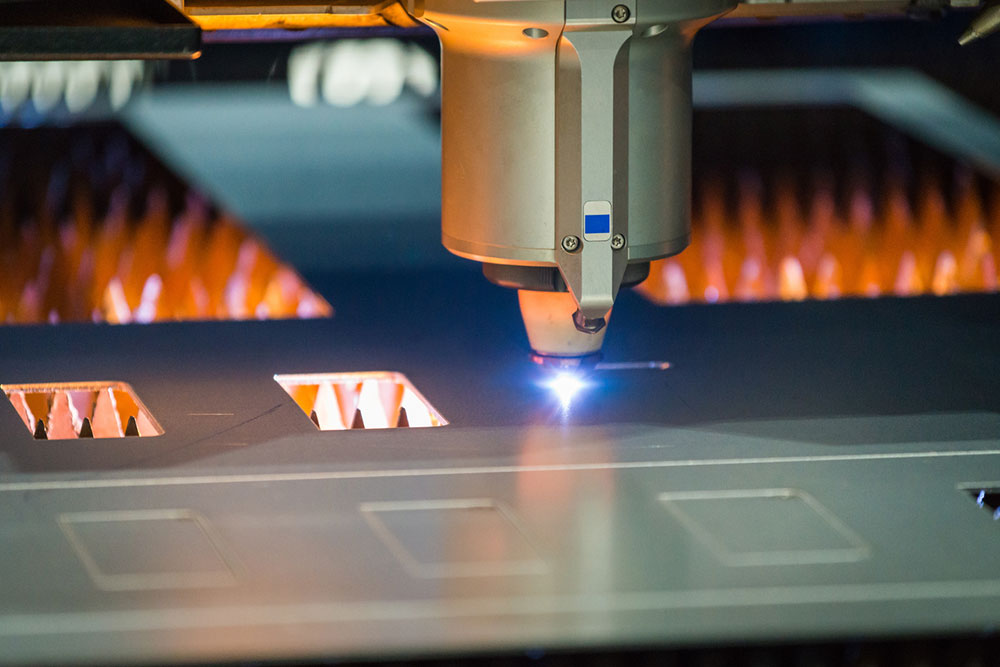
Laser cutting machines – Types, features, and uses
Laser cutting machines use high-powered laser beams to cut through different types of materials since this is one of the few technologies that can achieve micro-level accuracy. The machines come in different sizes and are used in multiple industries. Further, the technology was introduced not too long ago, and in recent years, it has gone through several advancements and has multiple applications, from drilling holes in diamonds to fabricating metals and aerospace manufacturing.
Overview of laser cutting machines
Laser cutters generate an ultraviolet beam or a concentrated fine ray of light using optical systems . It is focused on a workpiece with a design that requires cutting or engraving. As the beam moves along the lines, controlled by a Computerized Numerical Control (CNC) system, it creates precise engravings. Laser cutters use reflective mirrors, focus lenses, and servo motors to control machine movements. This technology is commonly used on materials like plastic, aluminum, brass, copper and other metals, plywood, medium-density fiberboard (MDF), hardwood, leather, rubber, ceramics, stones, and fabrics .
Types
The three main types of laser cutting machines are classified based on the type of laser source they use.
CO2 laser cutting machines
This type of machine uses a mixture of carbon dioxide (CO2) gas activated by electricity as the laser source, which is the component that generates the laser beam. Usually, CO2 laser cutters are used for engraving non-metallic materials like acrylic, wood, leather, paper, plastics, and fabrics, and they do not require much maintenance cost. But, in case of metals, these lasers tend to ignite spark and risk damaging both the machine and the material.
Fiber laser cutting machines
These machines use optical fibers with special elements to create laser beams. Fiber laser cutters are used for metal engraving and cutting, welding, additive manufacturing (3D printing), and even for reflective metals. While they are highly efficient and versatile, they require more investment and maintenance.
Nd :YAG or Nd :YVO4 lasers
These are crystal laser cutting processes that use solid-state crystal as the laser medium. Nd :YAG stands for neodymium-doped yttrium aluminum garnet and Nd :YVO4 stands for neodymium-doped yttrium orthovanadate, which are both crystals. The devices are quite precise and have a high and sustainable cutting power, so they are common in industrial use. While they are relatively costlier than other types of laser cutting machines, they have a higher life expectancy and can be used for both metal and non-metal materials.
Features
Versatile technology
Laser cutters can deal with an array of materials and apply to almost all industries that require cutting and fabrication. Apart from being versatile, they are also reliable and have a high turnover across industries.
Safe to use
Laser cutting machines have developed to the point that they are highly safe. With interlock systems, sensors, and enclosed cutting areas, these machines ensure workplace safety while operating them.
Customizable
The technology allows ample room for customization, especially in industries like interior design and art, where the needs and requirements are diverse.
Cost varies according to the material
Different laser cutters are used for different materials, and the cost varies accordingly. For example, fiber lasers for metals start from $30,000 while CO2 lasers for fabric and paper cost between $500 and $4,000. In fact, wood CO2 machines usually come for less than $1,000. But , industrial use machinery can drastically change the price point. For example, CO2 laser cutting machines for plastic used in industries can go up to $200,000 as opposed to $4,000 or less for personal or small business use.
Industry application of laser cutting machines
Metal industry
Laser cutters can be used for processing steel, copper, and aluminum for cutting edges and smoothening out surfaces through laser beams. This not only provides a high level of accuracy but also better product quality and higher productivity. This also saves a lot of operational costs, time, and labor cost .
Automobile
Auto parts like vehicle doors, chassis, and windows require extreme levels of accuracy to protect passenger safety. Any issues in these areas can lead to structural weaknesses and make vehicles prone to accidents. Laser beam machines are a common sight in the automotive industry for their efficiency. They bring precise fabrication and assembly of critical components.
Aerospace and defense
Like automobiles, both aerospace and defense require motors, turbine blades, structural parts, complex geometries, and equipment made from high-performing materials like nickel alloys, titanium alloys, and composite materials. Laser cutting machines can not only provide precision but also work with a wide variety of materials.
Architecture
Laser cutters can help cut metal sheets, glass, and decor items for both architecture and interior design industries. They also help execute intricate design patterns and ideas.
Electrical engineering
Laser cutting machines are common in electronics and electrical engineering. Electronics have several microscopic or tiny parts and complicated circuit boards with complex patterns. To avoid any errors and potential damage to the devices that can risk the life of a user , it’s important to ensure precise manufacturing.
In addition to these industries, laser cutting machines are also used in jewelry making, construction, and art and craft .




